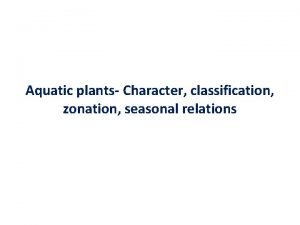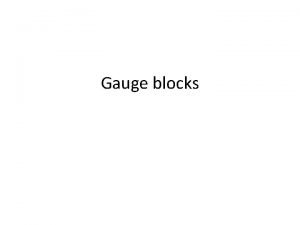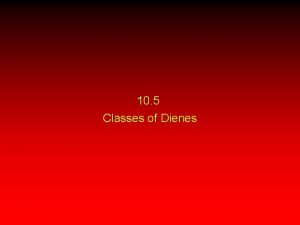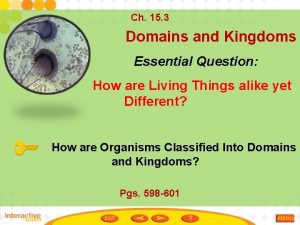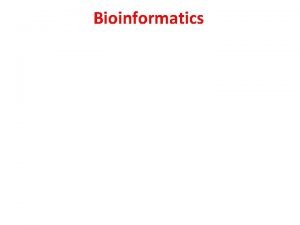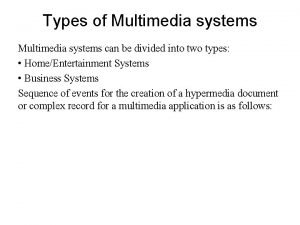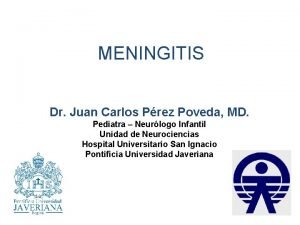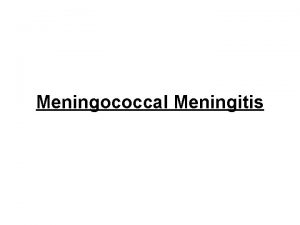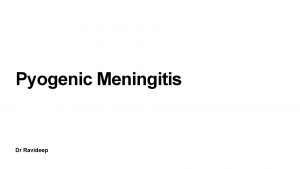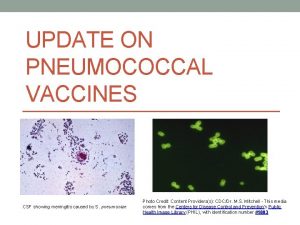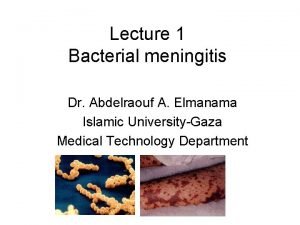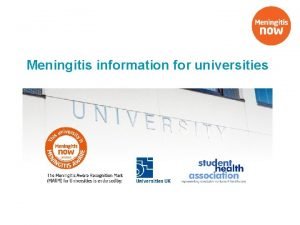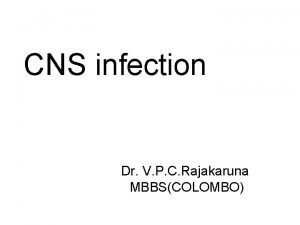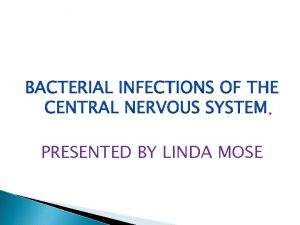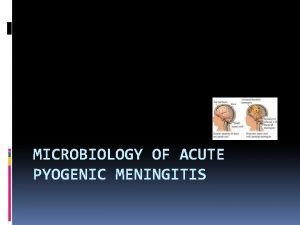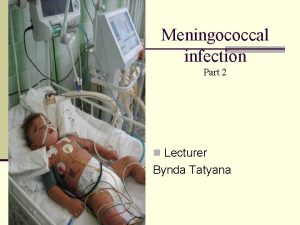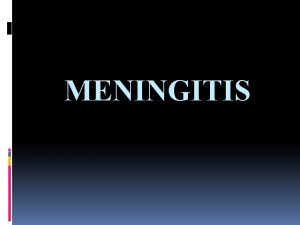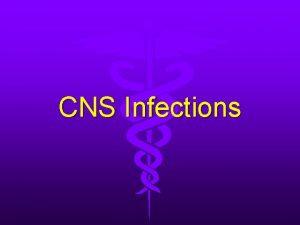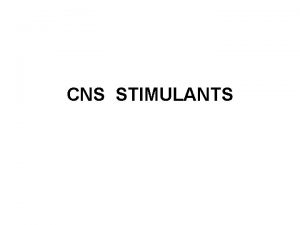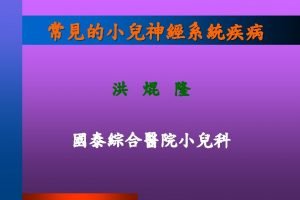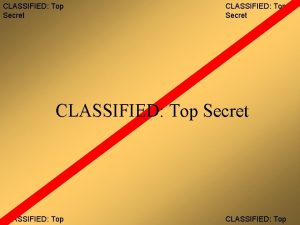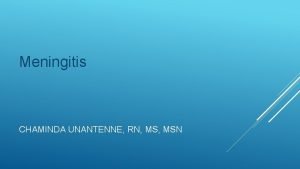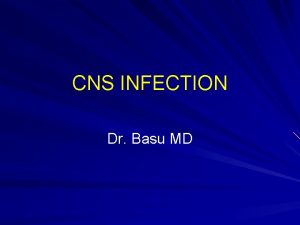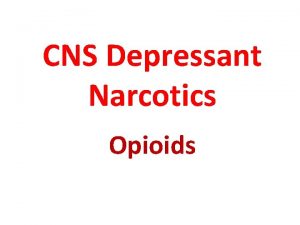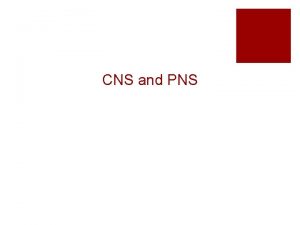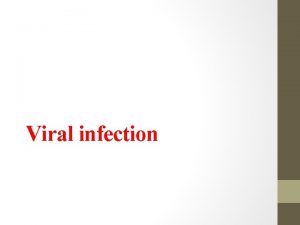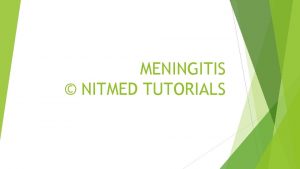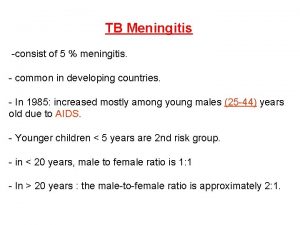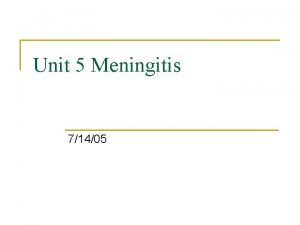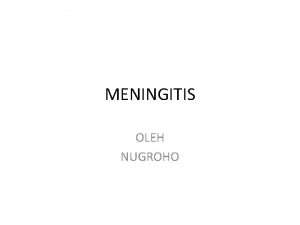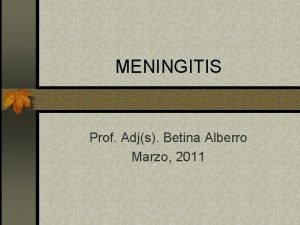CNS INFECTION CNS infection classified into q Meningitis





















- Slides: 21

CNS INFECTION

CNS infection classified into: q Meningitis q Encephalitis q Brain abscess q. Transverse myelitis

MENINGITIS Acute infection of the meninges presents with a characteristic combination of Pyrexia. Headache. Meningism, which can occur in other situations (e. g. subarachnoid haemorrhage), consists of stiffness of the neck, often with other signs of meningeal irritation: Kernig's sign (with the hip joint flexed, extension at the knee causes spasm in the hamstring muscles). Brudzinski's sign (passive flexion of the neck causes flexion of the thighs and knees).

MENINGITIS could be; be Viral Bacterial (TB, pyogenic). fungal Carcinomatous Acute 1 -3 days Subacute 3 d – 3 wk. Chronic more than 3 wk.

Bacterial meningitis The most 3 common organisms causing meningitis in young age group are: Strept. Pneumococci (mostly after age of 20) Neisseria. Meningococcal H. Influenza Strept. pneumia are the most common nowadays, but in a certain group of patients there is a predilection to develop pneumococcal type of meningitis especially in alcoholic , imunocompromised , splenectomaized patients and those with complement deficiency. Listeria monocytogens is a very important cause of meningitis in patients who are: Pregnancy Alcoholic Imunocompromised Elderly

Neonate Gram-negative bacilli (Escherichia coli, Proteus etc. ) Group B streptococci Pre-school child Haemophilus influenzae Older child and adult Neisseria meningitidis Streptococcus pneumoniae

Pathogenesis Bacterial infection reaches the CNS either by direct invasion haematogenous spread embolisation of infected thrombi. There can also be direct extension from contiguous structures via erosion of an osteomyelitic focus. iatrogenic (e. g. following ventriculo-peritoneal shunt, intracranial pressure monitor or surgery).

Risk factor

Clinical features Headache, drowsiness, fever and neck stiffness are the usual presenting features. In severe bacterial meningitis the patient may be comatose and later there may be focal neurological signs. Meningococcal meningitis is associated with a purpuric rash in 70% of cases.


Diagnosis q. Mortality rate is high in meningitis reaches 30 % in developed countries, so any delay in treatment wil 1 increase the percentage of mortality q. For diagnosis of meningitis, we need a high index of suspicion q. CT scan is not mandatory but it is preferable in meningitis we must examine fundi to ensure there is no raised ICP , then we do lumbar puncture to assess the CSF.


�Chemotherapy of bacterial meningitis N-meningitides Strep. pneumoniae Benzyl penicillin Cefotaxime �Sensitive to B-lactams Ceftriaxone �Resistant add Vancomycin H. Influenza Cefotaxime ceftriaxone Listeria monocytogens gentamicin Ampicillin +

�Treatment of pyogenic meningitis of unknown cause. I-patients with a typical meningococcal rash benzyl penicillin 2. 4 g. IV. 6 -hourly 2 -Adult aged 18 -50 years without meningococcal rash Cefotaxime 2 g IV. 6 -hourly Ceftriaxone 2 g IV. 12 -hourly 3 -Patient in whom penicillin-resistant pneumococcal infection is suspected Cefotaxime or ceftriaxone and add- Vancomycin I g Iv 12 -hourly 4 -Adult aged over 50 years and those in whom Listeria monocytogens suspected As for 2 but add Ampicillin 2 g IV 4 -hourly or Co-trimoxazole 5 -Patients with a clear history of anaphylaxis to B-lactams Chloramphenicol 25 mg/kg IV. 6 -hourly plus 1

�Steroid � Steroid must be given for all patients and preferable to be given before antibiotics, four hours before antibiotics then for 4 days only DEXAMETHASONE is preferable. Strept. is the most organism that benefit from steroid because it is the most to cause adhesion an hydrocephalus. Complication of meningococcal meningitis Rash Shock Renal failure Intravascular coagulation Pericarditis

�Major intracranialcomplicationof bacterial meningitis Transtentorial herniation Hydrocephalus Infarction Seizures

Chronic and recurrent meningitis Characteristic neurological syndrome persistent inflammation in CSF. Causes: Meningeal infection (TB , FUNGAL) Malignancy Chemical meningitis for>4 weeks &

Tuberculos meningitis � Account of 1 % of clinical TB � Increase with HIV � Long history of fever, vomiting, anorexia, focal neurological signs, urinary retension, reduce conscious. Symptoms Vomiting Low-grade fever Lassitude Depression' Confusion Behavioral changes

Signs Meningism (may be absent) Ocular palsies Cranial nerve palsies are common and often initially involve eye movements resulting from III, IV or VI nerve palsy. There may be facial weakness (VII), optic neuropathy (II), progressive hearing loss (VIII). Papilledema Depression of conscious level Focal hemispheric signs

Diagnosis CSF 1. The diagnosis is made by demonstration of AFB by ZN stain of CSF can use PCR. 2. CSF culture is the golden diagnostic tech take up to 6 weeks 3. slightly yellow, lymphocytic, with low glucose, and high protein Radiology patients may show evidence of previous TB on chest X-ray CT brain scanning is commonly abnormal There may be hydrocephalus, parenchymal enhancement, evidence of cerebral infarction or cerebral oedema or focal tuberculoma. MRI is sensitive in showing meningeal enhancement, focal parenchymal abnormalities or the development of communicating or obstructive hydrocephalus.

 Aquatic plants classification
Aquatic plants classification Classification of manufacturing process
Classification of manufacturing process Wringing of slip gauges
Wringing of slip gauges Cumulated dienes
Cumulated dienes Classification of woodwork hand tools
Classification of woodwork hand tools How are organisms classified into domains and kingdoms
How are organisms classified into domains and kingdoms Broadly classified
Broadly classified Prokaryotes are classified into
Prokaryotes are classified into Multimedia divides into which two categories?
Multimedia divides into which two categories? Meningitis viral antibiótico
Meningitis viral antibiótico Riwayat alamiah penyakit kusta
Riwayat alamiah penyakit kusta Meningitis
Meningitis Meningitis causes
Meningitis causes Vaccine for meningitis
Vaccine for meningitis Anatomy and physiology of meningitis ppt
Anatomy and physiology of meningitis ppt Meningitis causes
Meningitis causes Celss
Celss Dd of meningitis
Dd of meningitis Brudzinski sign
Brudzinski sign Csf analysis
Csf analysis Pyogenic meningitis definition
Pyogenic meningitis definition Partially treated bacterial meningitis csf
Partially treated bacterial meningitis csf
